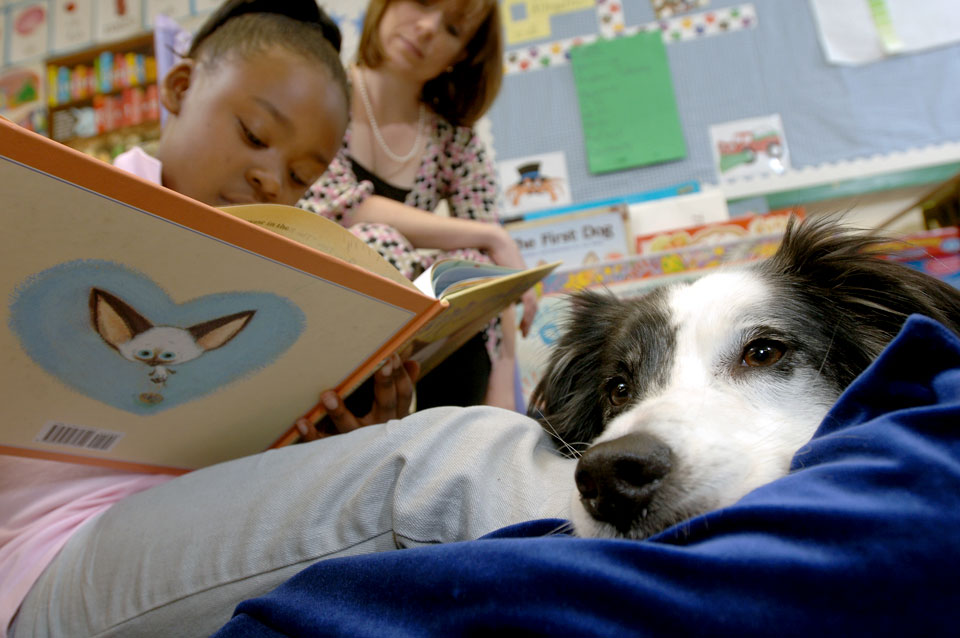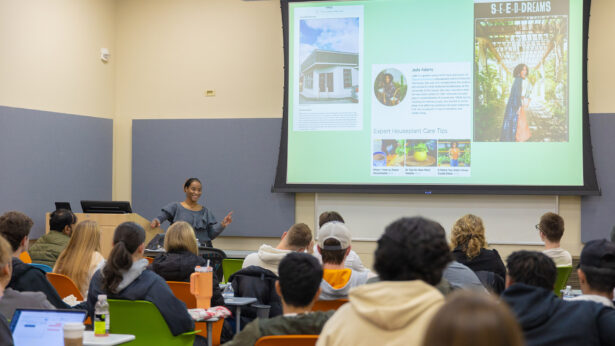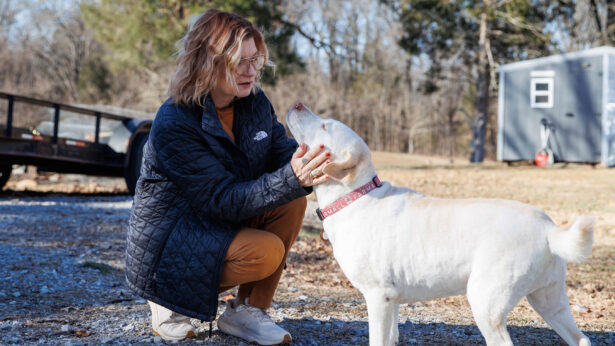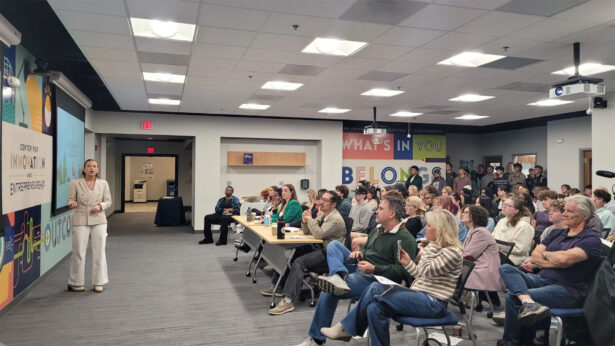By Sandra Harbison
Go, dog, go! Animals put children in comfort zone for reading
Blake, a student at Knoxville’s Belle Morris Elementary School, sits on the carpet reading V is for Volunteer: A Tennessee Alphabet in a soft voice. One hand holds the book as the other absentmindedly strokes Chili’s thick fur. Chili, a border collie mix, shows her appreciation with a wag of her tail and nudge of her nose.
Chili is half of a Human Animal Bond in Tennessee (HABIT) Ruff Reading team. At the other end of the leash is Blake’s second-grade teacher, Katherine Waring (Knoxville ’06, ’07).
HABIT is an animal-assisted therapy program sponsored by the UT College of Veterinary Medicine. HABIT volunteers take their dogs, cats and rabbits, who have been medically and behaviorally screened, to places such as nursing homes, assisted living centers, hospitals and schools. At 26, HABIT is one of the oldest programs of its kind in the country.
While schools have been part of the HABIT program since its inception in 1986, HABIT coordinator Karen Armsey says Ruff Reading fills a special niche. “Ruff Reading branched off from visitation in 2001, and it’s an easy sell,” explains Armsey. “It’s a natural fit: kids and dogs, kids and cats. Seeing a child relax as he reads to an animal makes people happy.” Ruff Reading is in at least one classroom or public library in 12 East Tennessee counties, and 100 animals don their bright red uniform scarves to do their Ruff Reading jobs each week.
Is it the human? Better books? Teacher’s style?
Research from the University of California, Davis, suggests dogs can help improve children’s reading fluency by double digits. When Ruff Reading first started in Waring’s class several years ago, an informal comparison of the second-grade classes’ reading scores at her school supported the findings.
Armsey muses, “Is it the human? Better books? Teacher’s style? We aren’t sure. What we do know, and it’s a glorious thing in these classrooms, is there’s another adult at the end of the leash the kids can count on each week.” A dog’s unconditional love and acceptance in the classroom enhances the learning process and builds students’ confidence and self-esteem.
“The dog doesn’t judge the student’s reading ability,” Armsey says. “The dog doesn’t correct the student. The dog just listens.”
Waring agrees. “It’s hard for some kids to read in front of other children, so this is totally different to them. The students know the dog isn’t going to snicker if they mispronounce something. That dog will love them no matter what.”
“When my first Ruff Reading volunteer team, Donna Silvey and her dog Boudreaux, came to my classroom three years ago, the kids were so quiet and polite while a student was reading to the dog,” says Waring. She believes they wanted the same respect when it was their turn. Silvey, a dedicated volunteer, knew the kids counted on her for “their turn” each week, and even when she had a broken leg, she enlisted friends to transport her and Boudreaux to Belle Morris.
Reading with Chili
When a fellow teacher expressed an interest in Ruff Reading, Waring, a firm believer in the program, decided to take the leash in her own hands and see if her dog, Chili, would qualify as a HABIT volunteer. She did, and while Chili can’t read books, she can read signs.
“I know she doesn’t know it’s Wednesday, but when she sees her red scarf on the kitchen counter, she knows it’s HABIT day and will jump in the car, furiously wagging her tail for me to hurry.”
One hour each Wednesday, students take turns reading to Chili. Waring says the experience has changed their attitude about reading. “Sometimes I think students viewed reading as some form of punishment, but now they want to practice reading for fun.”
Waring says her students use more expression when reading to a dog. “They know Chili loves squirrels, and she’ll perk her ears at even the word ‘squirrel.’ If we’re studying grammar and she’s in the class, the students get creative and work ‘squirrel’ into their sentences.”
Waring shares the story of a boy who transferred from another school. He was reading on a kindergarten level and, by the end of second grade, was reading on a fourth-grade level. “I don’t think he had really cared about reading before, but he loved dogs and practiced like crazy. With Donna encouraging him, him reading to the dog, me staying on his case and his parents helping him, it turned things around for him. There are tons of stories like that.”
On a recent Wednesday, while the rest of Waring’s class worked quietly in small groups, scouring their readers for nouns, pronouns and verbs in a grammatical scavenger hunt, Blake continued his Ruff Reading turn with Chili, his own personal Tennessee volunteer.
Learn more about HABIT at www.vet.utk.edu/habit.



